Author: Malcolm Frazer
To someone toying with the idea of homebrewing, the process of mashing grains then collecting the sweet prior to boiling can seem pretty daunting, especially given all the “rules” that exist for mash temperatures and what not. I’m pretty sure this is a large part of the reason most homebrewers start off using malt extracts, which can completely eliminate the need for a mash. Liquid malt extract (LME) is a viscous syrup that gets blended with water to create wort, and while many claim beers made with LME can be just as good beers made using all grain methods, the key to such success is often believed to be freshness.
I typically only use malt extract for making yeast starters and I also like to keep some around for OG correction on big beers. On a recent trip to my local homebrew shop, I picked up some Pilsner LME and realized after getting home that it was a bit older than I expected, packaged nearly a year prior to my purchasing it. This led me to do a little research on the shelf life of LME and I ended up finding the following on Briess’ website:
Store at temperatures <90ºF [32°C]. Best if used within 24 months from date of manufacture. Light-colored LME naturally darkens with age. Storing in a cool, dark location helps to minimize this effect.
Opening one of my year-old containers for use in a starter, I observed LME that was very dark, certainly more than I would expect for being made from Pilsner malt. When dilution didn’t rectify the issue, I couldn’t help but wonder how this age related darkening impacts beer characteristics, so I procured some fresh LME and designed an xBmt to test it out!
| PURPOSE |
To evaluate the differences between beers made with either 1 year old or 3 month old Pilsner liquid malt extract.
| METHODS |
Since the purpose of this xBmt was to evaluate how age of LME impacts beer, I designed a very simple recipe using 100% Pilsner LME.
Viscosity
Recipe Details
| Batch Size | Boil Time | IBU | SRM | Est. OG | Est. FG | ABV |
|---|---|---|---|---|---|---|
| 5 gal | 60 min | 39.5 IBUs | 4.4 SRM | 1.050 | 1.014 | 4.8 % |
| Actuals | 1.05 | 1.012 | 5.0 % | |||
Fermentables
| Name | Amount | % |
|---|---|---|
| Pilsner Liquid Extract | 8.187 lbs | 100 |
Hops
| Name | Amount | Time | Use | Form | Alpha % |
|---|---|---|---|---|---|
| Saaz | 40 g | 60 min | Boil | Pellet | 7 |
| Hallertauer Mittelfrueh | 28 g | 15 min | Boil | Pellet | 4 |
| Hallertauer Mittelfrueh | 14 g | 2 min | Boil | Pellet | 4 |
Yeast
| Name | Lab | Attenuation | Temperature |
|---|---|---|---|
| German Bock Lager (WLP833) | White Labs | 73% | 48°F - 55°F |
Notes
| Water Profile: Ca 104 | Mg 6 | Na 4 | SO4 100 | Cl 150 |
Download
| Download this recipe's BeerXML file |
Finding fresh LME was more of a task than I imagined, but I was eventually able to get my hands on a lot from the same manufacturer that had been packaged about 8 months after the stuff I’d previously picked up.
Given the absence of grains, very little went into preparing for this dual batch brew day. After collecting 2 equal volumes of RO water and adding a small amount of minerals to achieve my target profile, I immediately began heating one up and started the second 20 minutes later. I added equal amounts of LME to both kettles once the water was around 170°F/77°C.
I’d forgotten how quick and easy brewing with extract is, this was footloose and fancy free! The first batch reached a boil barely 30 minutes after I started brewing, a point at which I’m usually waiting on my mash to finish.
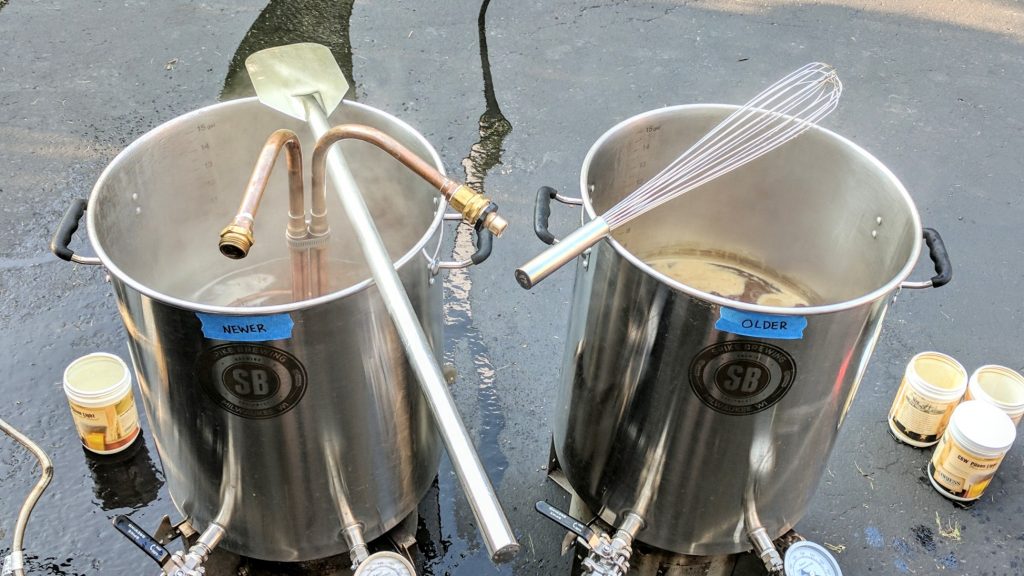
Although I love the smell of a mash, the aroma of these all LME batches brought fond back memories of making beer for my roommates. Each wort was boiled for 60 minutes with hops added as listed in the recipe.
At the end of each boil, I quickly chilled the worts to my target fermentation temperature of 48°F/9°C using a pre-chiller attached to my JaDeD Brewing Hydra IC.
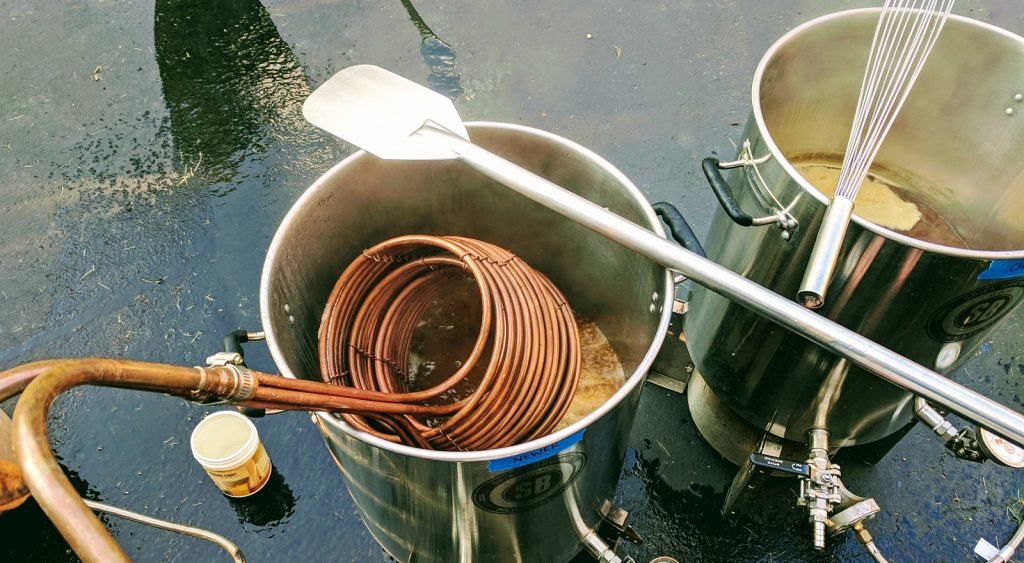
Equal amounts of wort were racked to identical glass carboys.
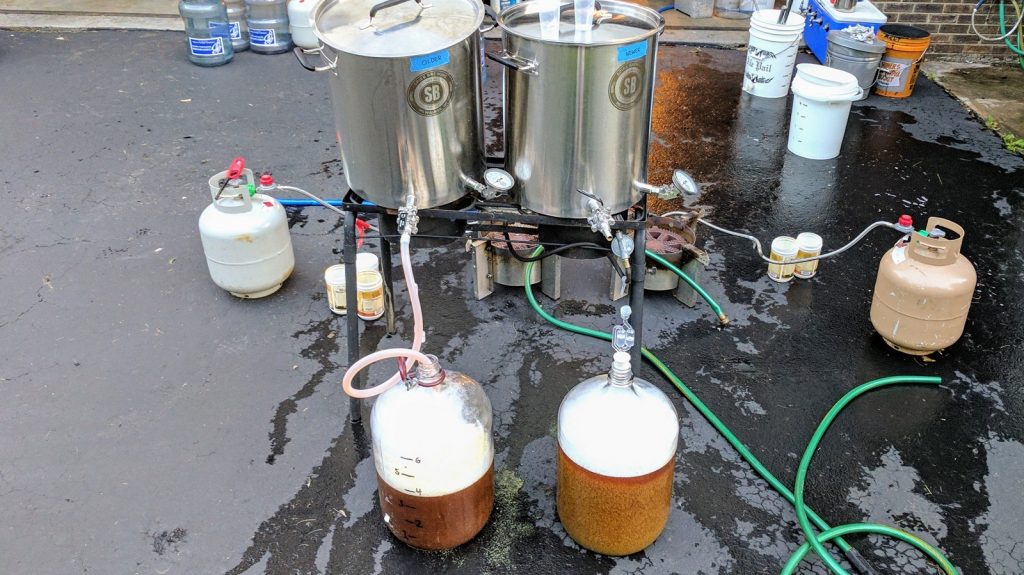
Out of curiosity, I took samples of both worts before and after the boil to monitor any changes in color.
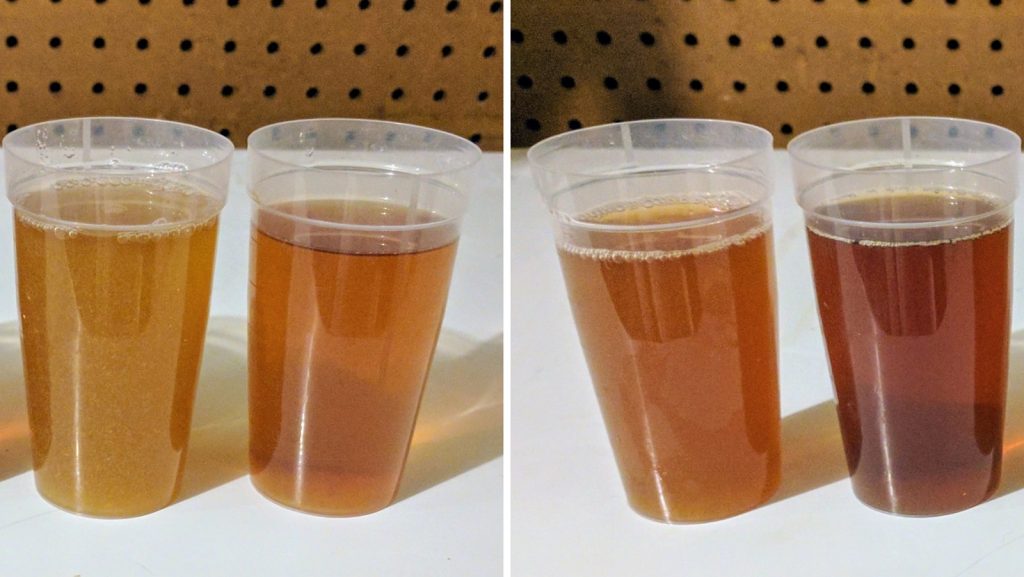
Hydrometer measurements revealed both worts hit the same OG, an undeniable testament to my amazing math skills :-/
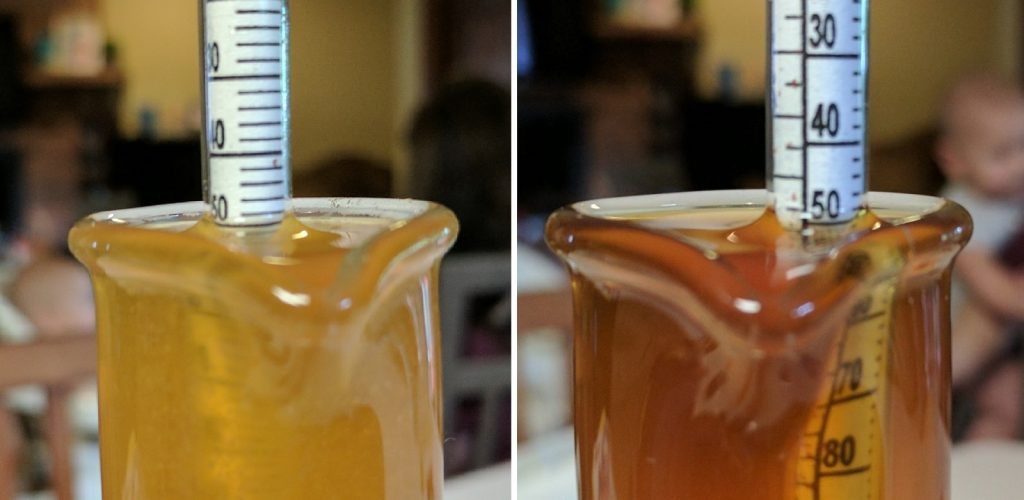
With both carboys sitting next to each other in my temperature controlled fermentation chamber, I split a large starter of Omega Yeast Labs Bock (OYL-111) that my friends at Helicon Brewing hooked me up with.
After hitting each batch with 90 seconds of pure oxygen, I closed the lid and left them alone. With a little wort from each batch leftover, I decided to check for any differences in pH and found them to be very similar.
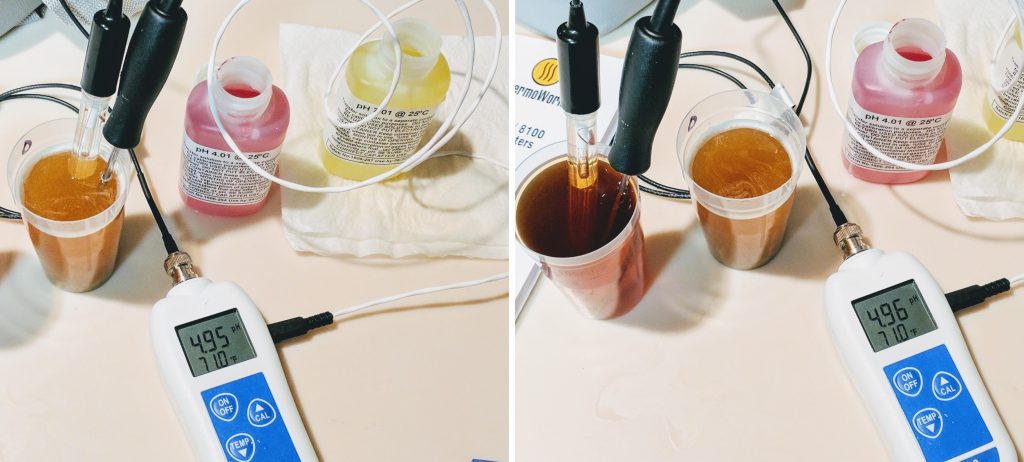
I opted for a traditional lager fermentation schedule and returned 12 hours later to actively fermenting beers.
After 2 weeks at 49°/9°C, I noticed activity had slowed considerably and took hydrometer measurements showing both beers were at nearly the same FG.
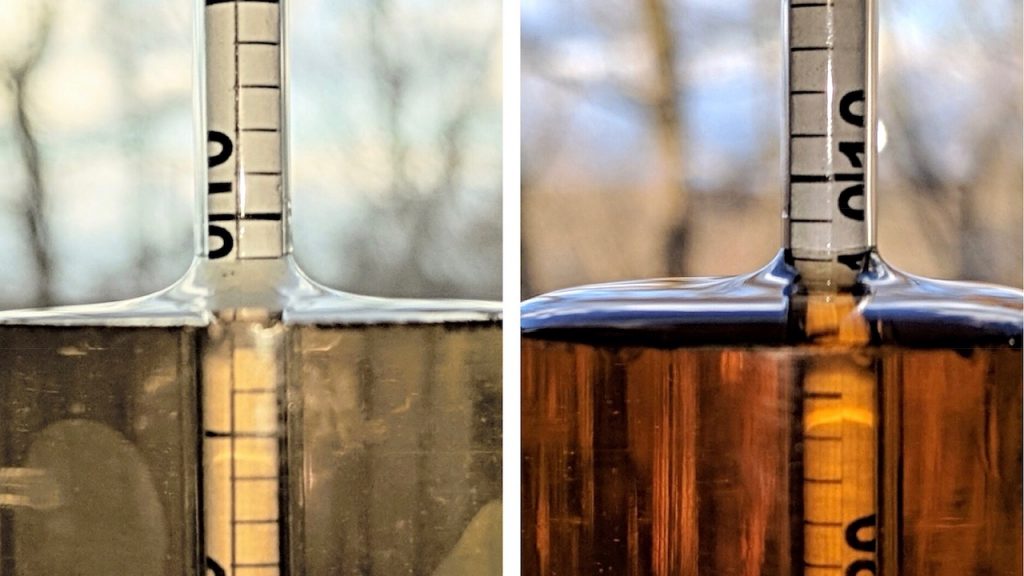
I transferred the beers to kegs and moved them into a chest freezer where I reduced the temperature to 34°F/1°C over the course of a few days. The beers lagered for 4 weeks before I pulled samples indicating they were carbonated, clear, and ready to serve.
| RESULTS |
A total of 35 people of varying levels of experience participated in this xBmt. Each participant was served 1 sample of the fresh LME beer and 2 samples of the beer made with old LME then asked to identify the sample that was unique. While 17 tasters (p<0.05) would have had to correctly identify the unique sample in order to reach statistical significance, 23 (p=0.00009) were able to do so, indicating participants in this xBmt were able to reliably distinguish a beer made 3 month old LME from one made with 1 year old LME.
The 23 participants who made the accurate selection on the triangle test were instructed to complete a brief preference survey comparing only the 2 beers that were different. A total of 11 reported preferring the fresh LME beer, 9 liked the old LME beer more, and 3 reported having no preference despite noticing a difference.
My Impressions: These beers were so starkly different to my understandably biased palate that I was able to select the unique sample in every triangle test I attempted. In both aroma and flavor, the beer made with fresh LME had a grain-like sweetness and oyster cracker finish compared to the caramel and melanoidin character I perceived in the old LME beer. I even thought the mouthfeel was different with the fresh LME beer being cleaner, drier, and lingering less on my palate. Selecting a preference was difficult because it sort of depends on the context. As a lager, the fresh LME was more inline with my expectations, but the old LME beer was actually nice too, it just had a stronger malt characteristic more reminiscent of a Scottish Ale.
| DISCUSSION |
Freshness is a concept known well to those in the food and beverage industry, largely believed to lead to a higher quality product. This is certainly the case when it comes to most brewing ingredients many of which are believed to change over time, and liquid malt extract is no exception. Based purely on the appearance differences between the fresh and old LME used in this xBmt, it was obvious age had an impact, which makes the fact tasters were able to distinguish between beers made with either not terribly surprising. Based on both post-survey conversations with participants and my personal experience, the beer made with fresh LME was lighter, crisper, and tasted more like the German Pilsner it was meant to be while the old LME beer was perceptibly more like a malty ale.
Freshness generally being positively related to quality, it might be easy to extrapolate the significant triangle test results as meaning the old LME beer was worse than the fresh LME beer, but that wasn’t necessarily the case. In fact, the preference ratings of the 23 participants who were correct on the triangle test were pretty evenly split, and I thought both were pretty tasty as well, even if they were noticeably different.
This was the first all LME beer I’ve brewed since 2001 and the experience was quite nostalgic. Because the fresh LME beer came back a tad sweeter and darker than I’d typically aim for with a German Pilsner, I decided to enter it as a German Helles Exportbier in the 2017 Beer And Sweat Keg-Only Competition and Festival, one of my favorite annual brewing events. While a BJCP Grand Master judge scored it a respectable 37 points, it was beat out by other beers. I’ll continue using malt extracts primarily for yeast starters and to adjust OG on big beers, though this experience reminded me that they can be used to make good beers!
If you have thoughts about this xBmt, please feel free to share in the comments section below!
Support Brülosophy In Style!
All designs are available in various colors and sizes on Amazon!
Follow Brülosophy on:
FACEBOOK | TWITTER | INSTAGRAM
If you enjoy this stuff and feel compelled to support Brulosophy.com, please check out the Support Us page for details on how you can very easily do so. Thanks!


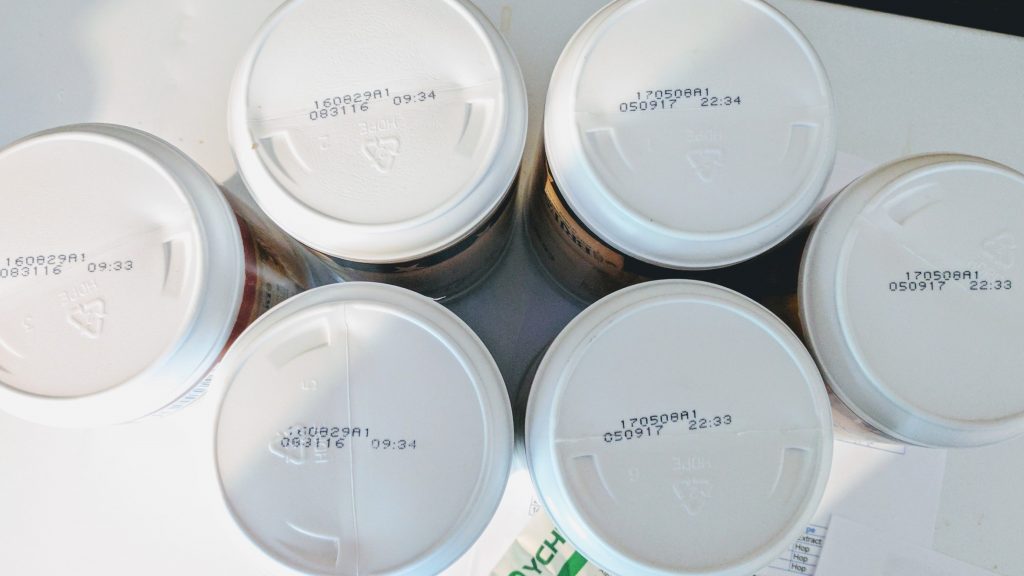
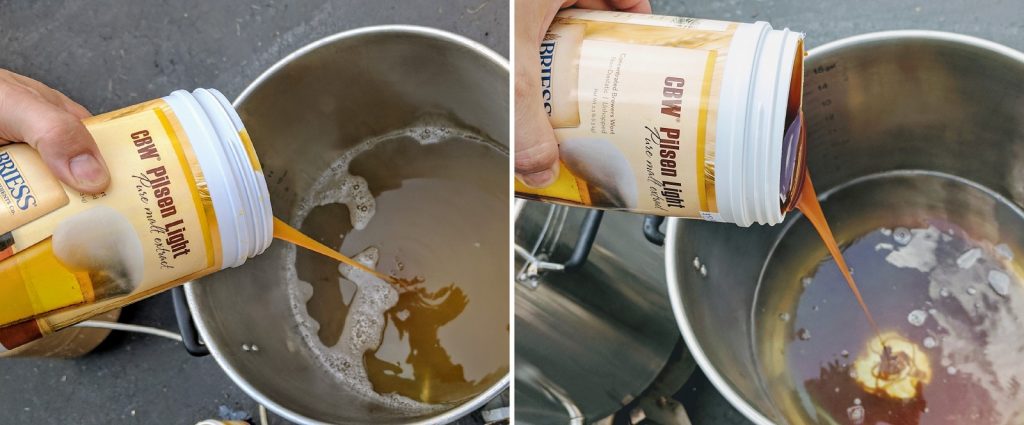
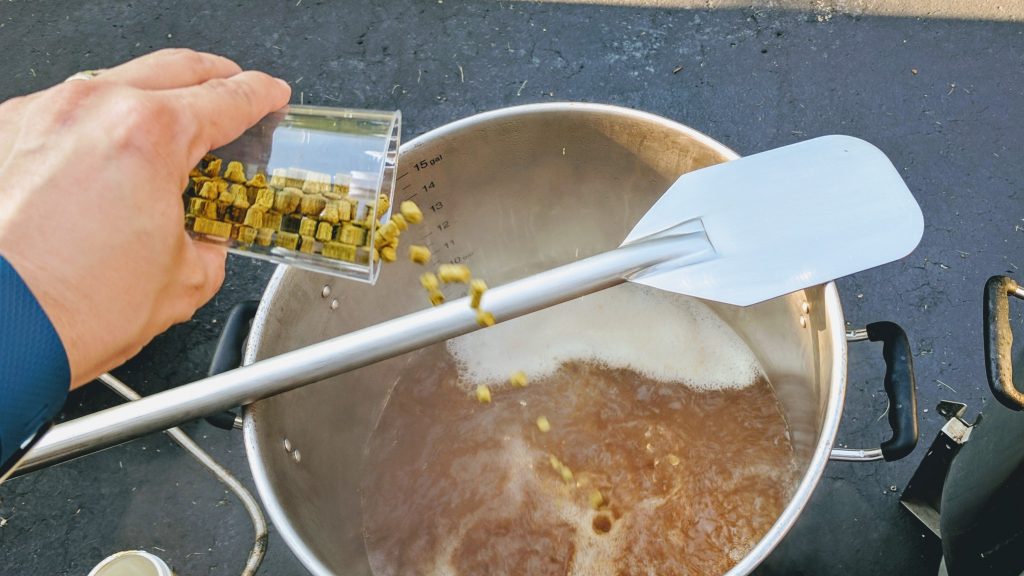
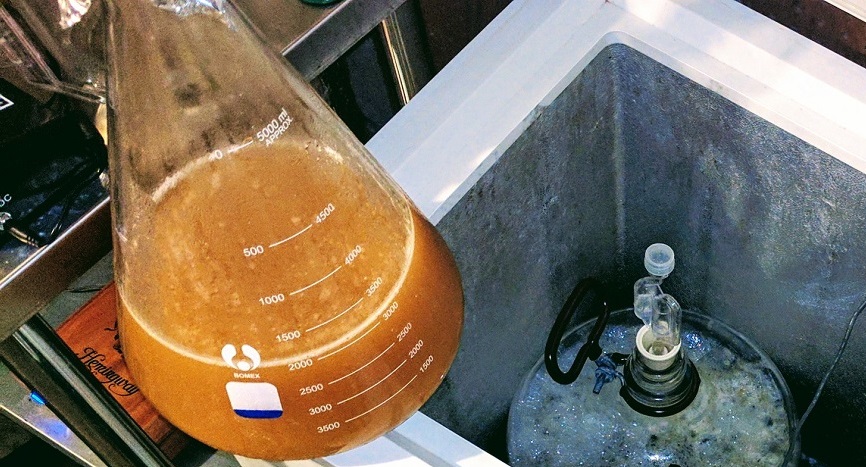
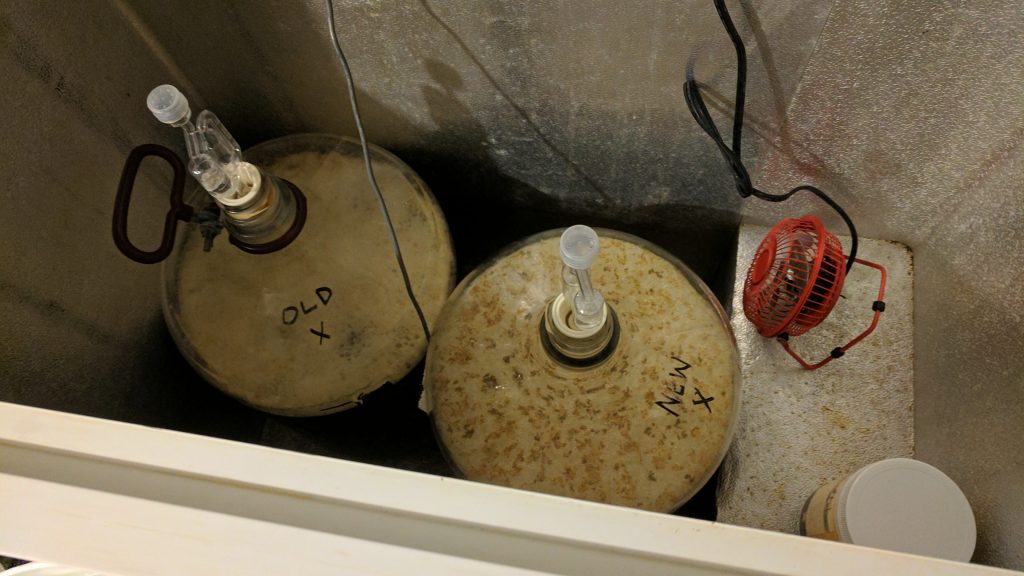
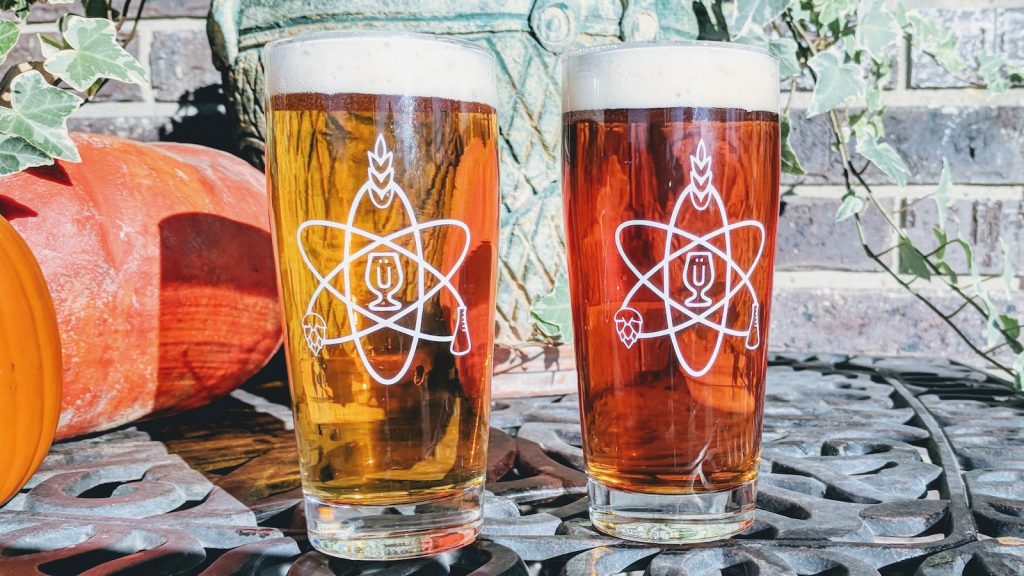











33 thoughts on “exBEERiment | Impact Using Old Liquid Malt Extract Has On A German Pils”
Is it true that DME stores much better than LME due to its lower water content? I’ve been told DME will not darken over time like LME does?
That is supposed to be the case due to lower moisture content.
I would love to see this xBmt repeated with DME! 🙂
Thank you for the experiment. Nothing groundbreaking but nice nevertheless.
You’re welcome. And thanks, I think. 😀
I typically only use wort left over from the last batch for making yeast starters and save some coin in the process.
Good method, I’ve used that technique when I’m brewing often.
I freeze leftover wort, and have it on hand for starters. However,I usually stick with dry yeast, and no starters at all…
Were the cups opaque when you did the triangle tests?
The last time I brewed a beer with 100% Pilsen LME it looked more like your old example. I am heartened that the fresh example does look like an all-grain beer in terms of color.
I worked at a LHBS that would receive and sell through 1-2 cases per week of Pilsen and Light LME from Briess, as well as Muntons Extra Light, Light, and Maris Otter. We were selling the freshest product we could. Even then the product goes through a lot of hands before it makes it to the shelf: manufacturer, to a distributor, to the LHBS’ warehouse, and then to the store shelf.
Your xBmt inspired me to check the date on two tins of Muntons Maris Otter LME I bought at the LHBS around 10 weeks ago. The BBE date was June 2019. Not too shabby!
Yes. Opaque cups – green, red, blue.
Aged LME could actually be a useful ingredient, based on your results.
One just needs to match it to the style.
I agree. Another tool in the toolbox, so to speak.
What type of IC do you use as pre-chiller? I just received my King Cobra, and don’t really like the idea of abandoning my little pre-chiller.
And old school homemade copper IC. Probably only 25ft.
If so, doesn’t that impact the effectiveness of the Jaded chiller greatly by adding additional hose length and decreasing the flow seeing as the pre-chiller is of a smaller ID? Or will the addition of the colder water make up for it?
Yes, it may impact the flow rate, and thus the ability of the JaDad to cool, all else being equal. that is precisely why the JaDed crew recommends short lengths of hose, to increase flow rate.
However, my ground water was only in the 70’s so I could only hope to get within a few degrees of that. As such, I used the Jaded to remove the bulk heat, got to say 80F in just a few minutes. Then switched to missiles and used the pre-chill stage to get to 48F. The prechill stage is just another IC in an icewater bath to chill the groundwater from 70’s to nearly freezing before it goes through the JaDed. I wish i had two Hydra it has a larger diameter thus less restriction and higher flow.
I was hoping you were going to be using a REALLY old malt extract. Like past the 24mo manufacturer’s suggestion.
May I ask why?
Just FYI, It was harder to find extract that old. So I would have had to buy it and wait. Which was an option.
FWIW, the data even at this spread was a statistically significant result.
Would be neat to try again but my guess would be an even greater ability to tell them apart. As to whether or not it would still be a nice beer? Not sure.
Another twist in the fresh vs stale comparison and like Bamforth, you observed that beers made with fresh vs stale extract were similarly preferred.
The color differences are much more evident that what I would have expected.
Great experiment, Malcolm!!
PS: why didn’t you enter it as a Bohemian Pils 🙂 ?
Hey Lupulus,
Yeah, the preference data is always interesting to me. It’s kind of one part science, but also a bit of a phycology experiment.
They are not told to base their preference upon what type of beer it was “supposed” to be. Just which one they preferred.
Interestingly, at least to me, a few people who are trained as beer judges and a few pro brewers did ask what it was supposed to be. I of course had to be coy and say just answer the question with the information you are provided (which is none – haha). I would have liked to have enough people to ask a data set which they preferred as a Pilsner or even a Scottish Ale.
Rather close at 11 to 9.
The newer extract beer was actually pretty decent. Didn’t quite have the body and the smoothness and certainly not the diacetyl of a bohemian, at least not to my impression. I admit I considered it. Had it been a bit bigger a Maibock may have worked as well.
I usually only make mead and am not too familiar with LME. As it ages, does it develop crystals like syrup and honey?
Can LME be restored by warming gently and dissolving in water first, like when making a mead?
Interesting stuff. “Common wisdom” would have us believe that aside from being darker, the old LME beer should taste like ball point pen ink and be an embarrassment to anyone that came within 10 feet of it.
If your only aim is good tasting beer (and you couldn’t care less about repeatability or styles), it seems like quality fermentation can make up for a lot of flaws elsewhere in the process.
Thanks for expanding our horizons yet again!
The older LME beer was not horrendous. 9 people out of the 23 who were able to distinguish preferred it to the Newer LME beer (without regard to style). 3 had no preference. 11 preferred the Newer LME beer.
A newspaper style headline could be:
“Almost 70% of the tasters found the older LME beer to be equal or better than the fresh LME beer”
I made an AIPA last month and it was bad. As mentioned in the article, mine tasted like a Scottish ale on steroids. Very dark, like around 10 srm. I still have some left and this time I am going to only boil it for 15 minutes. Just like basic brewing radio’s : 15 minute IPA”. Not sure if that will help, but doing it soon.
This might be one of the reasons why British brewers often used a small portion of malt extract in the 1945-1980 period. Might have led to the American belief in concentrating a portion of wort for Scottish ales too.
http://barclayperkins.blogspot.co.uk/2016/11/malt-extract.html
Interesting results. Here’s a suggestion for another extract exbeeriment. Full boil vs partial boil extract batch. I’ve read that full boil is better for hop utilization and results in a lighter colored beer. I’ve done both partial and full boil extract batches and never noticed a difference but I didn’t do side-by-side comparisons. Maybe test it out using a pale hoppy beer?
Did you notice the infamous “Extract Twang?”
Nah. Both beers were fine. But the older LME batch was certainly not what I would typically expect from a pilsner.
I Brew primarily extract beer, and take it really seriously.. to the point that I’m now going down the road of water chemistry. Can you elaborate on your water chemistry decisions for this batch? How did you account for the mineral content in the extract? I would love to know what I’m doing regarding that.. I’ve started using distilled water, and noticed an improvement over bottled water, which was an improvement over tap water, but I’m ready to go a step further. Can you help me? Thanks!
Will try your method of brewing, It looks perfect. Thanks for sharing this, It will help me a lot.
I recently brewed an all extract Kolsch from a kit I purchased in 2014. Yep, 5 year old extract. It was very dark in color, almost Porter dark, but the beer turned out decent. I served it at a party of mainly Bud light drinkers and almost everyone commented about how light and refreshing it was for a “dark beer”. I definitely picked up on the Carmel notes you mentioned, and I thought it might have had a bit more residual sweetness than I expected it to. Thanks for the in depth test.
Great article. Just finished primary fermentation of some BBE 2016 liquid malt extract. I’m new to brewing but it’s pretty obvious to me that what I’ve made isn’t a golden ale. Glad to see my experience fits the data